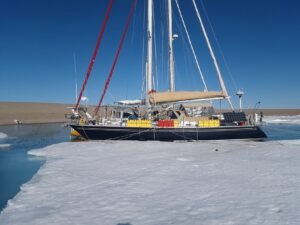There are many who insist that only a metal boat should go into the ice-fraught waters. Between the danger of hitting a bergy bit in open water, or getting squeezed by pack ice, it would seem like anything less ductile than steel or aluminum would be unsafe. But we transited the NWP with a fiberglass hull, as have a minority of others, and I would confidently do so again. That being said, I would not do any high latitude sailing among ice with a lightweight cored fiberglass hull: it would have to be solid laminate, with a pretty beefy layup. It’s not so much the danger of hitting big chunks, which can be avoided by a careful watch in the perpetual daylight that prevails during the navigable season; it’s the necessity of working through pack ice, and to sustain a certain amount of squeezing when the ice presses in. Inevitably, small bits of brash ice will be bumped into, and perhaps bigger pieces at slow speed, and a solid hull will lend confidence in that scenario. But nothing we encountered made me fear for the integrity of the hull.

One big disadvantage of a metal boat in cold climates, though, is that metals are great at transferring heat, and every inch of surface, both above and below the water, are doing their best to make the inside as cold as the outside. That means that even with the living spaces insulated, the life-giving warmth that’s so important to comfort and to morale will be harder to achieve and sustain. Even a fiberglass hull without proper insulation and heat becomes a condensation bath—how much more a metal one!
But moving on from material, let’s discuss design: because there will be pack ice pressing in sometimes, and often the ice has underwater shelves that can poke under the boat, any fragile structure underneath is a liability. It should be obvious that a bulb keel and spade rudder boat will be completely unsuitable—one French built “expedition” boat suffered damage to one of her rudders in the ice, and while the lifting keel allowed her to run into shallow areas, she couldn’t steer worth a hill of beans with it up.
Polar Sun, the Stevens 47 we did the passage in, had a longer fin keel and skeg-hung rudder. Though better, this was still less than ideal. The bow, with very little substance forward, tended to ride up onto floes as we tried to shoulder them aside. This in turn endangered the forward-looking-sonar transducer, which dangled unprotected from the hull forward of the keel. Back aft, the trailing edge of the rudder had to be carefully watched. The idea that an inboard rudder will be protected from ice by the stern is quickly seen as a gross misconception the first time an ice floe extends an underwater shelf toward it; and the design of skeg-hung inboard rudders is such that they carry a lot of fragile area really far aft of the shaft, which just begs for damage from passing ice.
The best design for high latitude sailing and milling about among the ice, then, will be a full-keel boat with stern-hung rudder. With a plumb bow that will wedge between floes to open up a path, a strongly-hung rudder that can be visually inspected always, and a fair hull without sudden turns or angles underwater, it’s clearly superior for that sort of work. The high-volume hull is ideal for maximizing interior storage and tankage space—space necessary to carry all the extra stores and supplies that a voyage like that demands.

An enclosure to protect the helm from cold is desirable: someplace sheltered from the icy wind with a good all-around view, since keeping a good watch is critical among ice. Polar Sun had a canvas and isinglass hut that while adequate, had not been designed with practicality in view. A hard enclosure would be better, one with a solid roof to stand on while tending the sail, and that didn’t restrict access to the winches. In short—sailing is difficult enough in cold climates without the need to battle with flapping canvas panels and limited winching ability.

The vast distances that must be covered in a very short season make it necessary to have good motoring range; boats with inadequate fuel tankage wind up lashing dozens of jerrycans on deck, and one boat even had two 55-gallon drums lashed up there. This is an undesirable scenario in regular cruising: in the hard sailing that one encounters in high latitudes, it’s positively a killer. Bringing up the boat’s center of gravity is bad for stability, and cluttering up the deck with obstacles is dangerous. With mobility already restricted by layers of clothing (more on that in another section), a cluttered deck makes movement even more difficult.
Which brings me to the next design consideration: that the ideal high-latitude boat will have a bulwark tall enough to obviate the need for lifelines. Not only will this result in less water washing over the decks, it will make moving about on deck far safer, since lifelines have little power to stop people washing right out under. “But what about windage?” the bulwark-denier will claim. Well, is it better to have a fair, smooth bulwark or what amounts to far more windage anyway, with cans lashed to the lifelines, dinghy on the foredeck, a man-high enclosure around the cockpit, and in some boats, canvas spray cloths, not to mention solar arrays, fenders tied to the rail, and all the other impedimenta of modern cruising life? Windage, forsooth! Any bulwark is better than none, but one at least knee-high will have enormous advantages.